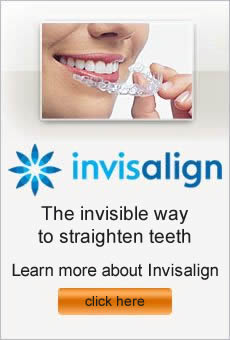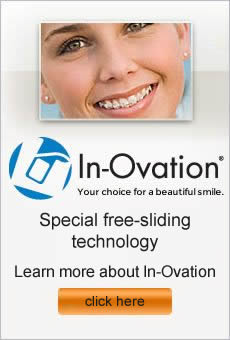For a long time the only option to straighten teeth were metal braces and wires. Although this orthodontia serves a purpose, it creates a less-than-appealing image, especially for adults seeking treatment. Now, older teen and adult patients can enjoy gorgeous smiles without the hassle and embarrassment of traditional orthodontia.
Systems like Invisalign and ClearCorrect utilize custom, acrylic aligners to gently shift teeth into the desired position. Adult patients often choose this type of orthodontia because it offers advantages to metal braces, including:
Convenience
With the clear aligner systems, your orthodontist will take images and gather data so that a dental lab can fabricate your complete set of aligners. You wear each set for about two weeks and then move on to the next ones. Usually, the orthodontist will check your progress every six weeks.
Appearance
Constructed from clear plastic, Invisalign and ClearCorrect aligners are barely discernible to friends and family, allowing you to look great while you straighten your teeth. Only you and your orthodontist will know that you are undergoing treatment.
Flexibility
Because you can remove the aligners, patients are able to take them out for special events or important meetings. For optimal results, you need to wear the aligners about 22 hours a day.
Health
Often, traditional braces make brushing and flossing more difficult, which can contribute to dental issues like gum disease or tooth decay. With the Invisalign and ClearCorrect aligners, you remove the trays to brush and floss as you would normally.
Removable Orthodontic Aligners at Mehdi Fotovat Sherman Oaks Orthodontist
When most people think about orthodontics, they envision braces or retainers. Sometimes, your orthodontist may recommend a temporary anchorage device (TAD). Made of titanium alloy, the TAD is a miniature screw that serves as an anchor to move teeth in a very controlled manner. Because the TAD does not move, the tooth or teeth can move against a fixed point to create the desired results.
Your orthodontist can place the TAD in the office, with minimal discomfort. After numbing the area with a fast-acting gel and applying local anesthetic, the doctor will insert the appliance through the gums into the bone between your teeth. Most people experience a feeling of some pressure, but no actual pain. Usually, patients respond well to the procedure, with no need for even over-the-counter medications like ibuprofen or acetaminophen.
Because the device is temporary, your doctor will monitor the progress and remove the screw once the teeth have shifted as desired. Usually, patients only wear TADs for a few months. If the TAD irritates your cheeks or lips, use a q-tip to apply orthodontic wax and cover the device. Call your doctor if the discomfort persists.
For the first week, rinse the TAD with chlorhexidine two to three times daily. You will also need to use a soft toothbrush dipped in chlorhexidine to brush around the post during the initial seven days after placement. After this point, treat the TAD like a tooth by brushing at normal times. With a TAD, you may feel some loosening, which is normal. If it feels excessively loose or becomes uncomfortable, contact your orthodontist.
Temporary Orthodontic Appliances at Mehdi Fotovat Sherman Oaks Orthodontist
When people think about orthodontic treatment, they usually imagine braces. Although braces are a common form of therapy, orthodontists utilize other appliances as well. Depending on the situation, your orthodontist may recommend the following orthodontic devices:
Braces
The most recognizable orthodontic appliances, braces are the brackets or aligners used to shift teeth into the desired position. Traditional braces involve metal brackets and wires, but modern advances have provided other options such as lingual braces, ceramic brackets, and Invisalign clear aligners.
Retainers
Once you complete treatment with braces, your orthodontist will likely fit you for a retainer, which is designed to keep teeth from moving out of alignment. Usually, retainers are worn almost constantly at first and then less frequently for maintenance purposes.
Rapid Palatal Expander (RPE)
Generally used for crowding of upper teeth or on a narrow jaw, the rapid palatal expander (RPE) is placed in the roof of the mouth and turned with a special key to increase the upper jaw area. Expanders are typically in place for about four to six months.
Headgear
When patients have a severe overjet or their teeth need significant repositioning, the orthodontist may recommend head gear. Connected to the upper bands, head gear guides the jaw growth in the right direction.
Thumb Guard
As permanent teeth begin to erupt, thumb sucking can create issues and cause alignment problems. A thumb guard, which is positioned in the roof of the mouth, stops the thumb from pushing up against the front teeth.
Common Orthodontic Appliances at Mehdi Fotovat Sherman Oaks Orthodontist
Affecting one of every 700 babies annually, a cleft palate is a common birth defect that results in facial or oral malformations. With a cleft palate, a split or opening occurs in the roof of the mouth and can impact the hard and/or soft palate. A cleft lip is a split or separation of the two sides of the upper lip. These defects can occur on one or both sides of the mouth. In fact, patients can have a cleft palate without a cleft lip, a cleft lip without a cleft palate, or both a cleft lip and cleft palate.
Most of the causes of a cleft defect are unknown. These issues typically occur very early in pregnancy. A cleft palate or cleft lip develops when not enough tissue is present or the tissue does not join together properly.
Because cleft defects create an obvious physical manifestation, diagnosing these deformities is usually easy. Sometimes, an ultrasound will pick up a cleft palate or cleft lip. If that doesn’t happen, the physical signs are often identified and confirmed at birth.
Cleft palates and cleft lips can cause difficulties such as eating problems, hearing concerns, speech delays, and dental issues. Children with cleft palates or cleft lips often have an increased risk of cavities as well as extra, missing, or malformed teeth. Part of treatment involves addressing oral health concerns.
Treatment for cleft palate issues begins in infancy and can continue into adulthood. Usually, children diagnosed with cleft palate deformities will have a team of doctors and specialists, including:
• A plastic surgeon to address the physical appearance
• An ear, nose, and throat doctor to evaluate and treat hearing issues
• An oral surgeon to reposition the upper jaw as needed and repair a cleft impacting the gum area
• An orthodontist to straighten the bite and teeth
• A dentist for routine dental care
• A speech pathologist to identify speech and feeding problems
• A speech therapist to work on language development
We care about your smile at Mehdi Fotovat Sherman Oaks Orthodontist
Although many adults may feel embarrassed by their crooked teeth, the idea of metal braces may seem even worse. Advances in technology have made it possible for orthodontists to offer treatments that will produce gorgeous results without drawing attention to your orthodontic therapy.
Orthodontics is often seen as treatment for kids and teenagers, but it can actually correct bite issues, address crowding, and straighten teeth for patients of any age. You are never too old to reap the benefits of a fabulous smile. Not only will a straight smile look better, but it can also improve your dental health. Crooked, crowded, or gapped teeth can make routine care more difficult, which can increase the chances of developing issues like tooth decay or gum disease.
Before recommending treatment, your orthodontist will likely take X-rays and perform a complete examination. Once the doctor has gathered all the information, he or she will explain your options for treatment. Many adults prefer the following orthodontic therapies:
Ceramic brackets
Similar to traditional wire-and-bracket braces, ceramic brackets are constructed from tooth-colored materials. With ceramic brackets, only the connecting wires are visible, which makes these braces much less noticeable than with metal orthodontia.
Lingual braces
Applied to the back side of teeth, lingual braces aren’t apparent when you smile. These braces take some getting used to and they may cost more than other options, but they provide adults with inconspicuous orthodontic treatment.
Clear aligners
With options such as ClearCorrect or Invisalign, patients can achieve flawless smiles without the hassle and discomfort of traditional metal braces. These systems use clear, custom aligners to gently move teeth into the desired position. Because the aligners are removable, patients can take them out to eat, brush, or for special occasions.
Adult Braces at Mehdi Fotovat Sherman Oaks Orthodontist



